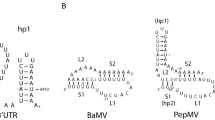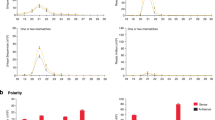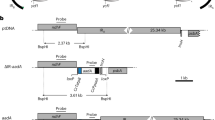Abstract
Processed pseudogenes are a common feature of mammalian multi-gene families and 'single-copy' genes1–3. They are considered to result from integration into the genome of reverse transcripts of cytoplasmic poly(A) + messenger RNA of genes that are expressed in the germ line. The paucity or absence of processed pseudogenes in animal groups other than mammals, despite the presence of endogenous viral retroposons encoding reverse transcriptase4, has led to the suggestion that this disparity might be the result of differences in the duration of gametogenesis3. In contrast to animals, plants lack a germ line: plant gametes differentiate from cells that have been actively engaged in organizing the somatic tissue of the plant, in the apical meristem. Pseudogenes of somati-cally expressed genes could therefore appear eventually in the gametes. Although reverse transcription is known to be involved in the replication of the cauliflower mosaic virus5–7, and retrotrans-posons have been described in wheat and maize8–10, surprisingly no plant processed pseudogene has been reported. We report here the nucleotide sequence of an actin gene from potato (Solanum tuberosum) which has all the characteristic features of a typical mammalian processed pseudogene. This potato processed pseudogene might be the first of many that are yet to be discovered. Alternatively, it might be a rare event because some, as yet, unknown factors affect the different rates of pseudogene production in animals and plants.
This is a preview of subscription content, access via your institution
Access options
Subscribe to this journal
Receive 51 print issues and online access
$199.00 per year
only $3.90 per issue
Buy this article
- Purchase on Springer Link
- Instant access to full article PDF
Prices may be subject to local taxes which are calculated during checkout
Similar content being viewed by others
References
1. Vanin, E. F. Biochem. biophys. Acta 782, 231–241 (1984). 2. Wilde, C. D. CRC crit. Rev. Biochem. 19, 323–352 (1986). 3. Weiner, A. M., Deininger, P. L. & Efstratiadis, A. A, Rev. Biochem. 55, 631–661 (1986). 4. Mount, S. M. & Rubin, G. M. Molec. cell. Biol. 5, 1630–1638 (1985). 5. Hull, R. & Covey, S. N. Trends biochem. Sci. 8, 119–121 (1983). 6. Pfeiffer, P. & Hohn, T. Cell 33, 781–789 (1983). 7. Guilley, H., Richards, K. E. & Jonard, G. EMBO J. 2, 277–282 (1983). 8. Shepherd, N. S. et al. Nature 307, 185–187 (1984). 9. Harris, N. & Flavell, R. B. Heredity 57, 276–277 (1986). 10. Johns, M. A., Mottinger, V. & Freeling, M. EMBO. J. 4, 1093–1101 (1984). 11. Moss, M. & Gallwitz, D. Nucleic Acids Res. 10, 7843–7849 (1982). 12. Moss, M. & Gallwitz, D. EMBO J. 2, 757–761 (1983). 13. Tokunaga, K., Yoda, K. & Sakiyama, S. Nucleic Acids Res. 13, 3031–3042 (1985). 14. Dente, L., Cesareni, G. & Cortese, R. Nucleic Acids Res. 11, 1645–1655 (1983). 15. Poncz, M., Solowiejczyk, D., Ballantine, M., Schwartz, E. & Surrey, S. Proc. natn. Acad. Sci. U.S.A. 79, 4298–4302 (1982). 16. Sanger, F., Nicklen, S. & Coulson, A. R. Proc. natn. Acad. Sci. USA 74, 5463–5467 (1977).
Author information
Authors and Affiliations
Rights and permissions
About this article
Cite this article
Drouin, G., Dover, G. A plant processed pseudogene. Nature 328, 557–558 (1987). https://doi.org/10.1038/328557a0
Received:
Accepted:
Issue Date:
DOI: https://doi.org/10.1038/328557a0
This article is cited by
-
Processed Pseudogenes, Processed Genes, and Spontaneous Mutations in the Arabidopsis Genome
Journal of Molecular Evolution (2006)
-
A major cysteine proteinase, EPB, in germinating barley seeds: structure of two intronless genes and regulation of expression
Plant Molecular Biology (1996)
-
A cdc2 homologue and closely related processed retropseudogenes from Norway spruce
Plant Molecular Biology (1995)
-
An analysis of retroposition in plants based on a family of SINEs from Brassica napus
Journal of Molecular Evolution (1994)
-
A putative β-glucanase pseudogene behind the potato GBSS gene
Plant Molecular Biology (1993)
Comments
By submitting a comment you agree to abide by our Terms and Community Guidelines. If you find something abusive or that does not comply with our terms or guidelines please flag it as inappropriate.



